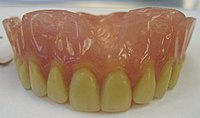
Photo from wikipedia
The introduction of new digital technologies represents an important advance to fabricate metal–ceramic restorations. However, few studies have evaluated the influence of these technologies on the fit of the restorations.… Click to show full abstract
The introduction of new digital technologies represents an important advance to fabricate metal–ceramic restorations. However, few studies have evaluated the influence of these technologies on the fit of the restorations. The aim of this study was to evaluate the effect of different manufacturing techniques and pontic design on the vertical marginal fit of cobalt–-chromium (Co–Cr) posterior fixed partial dentures (FPDs) frameworks. Methods: Eighty stainless-steel dies were prepared to receive 3-unit FPDs frameworks with intermediate pontic (n = 40) and cantilever pontic (n = 40). Within each design, the specimens were randomly divided into four groups (n = 10 each) depending on the manufacturing technique: casting (CM), direct metal laser sintering (LS), soft metal milling (SM), and hard metal milling (HM). The frameworks were luted, and the vertical marginal discrepancy was assessed. Data analysis was made using Kruskal–Wallis and Mann–Whitney U tests (α = 0.05). Results: The vertical marginal discrepancy values of all FPDs were below 50 μm. The HM frameworks obtained the lowest misfit values in both designs. However, no differences were found among intermediate pontic groups or cantilevered groups. Likewise, when differences in a marginal discrepancy between both framework designs were analyzed, no differences were observed. Conclusions: The analyzed digital technologies demonstrated high precision of fit on Co–Cr frameworks and on both pontic designs.
Journal Title: Applied Sciences
Year Published: 2021
Link to full text (if available)
Share on Social Media: Sign Up to like & get
recommendations!